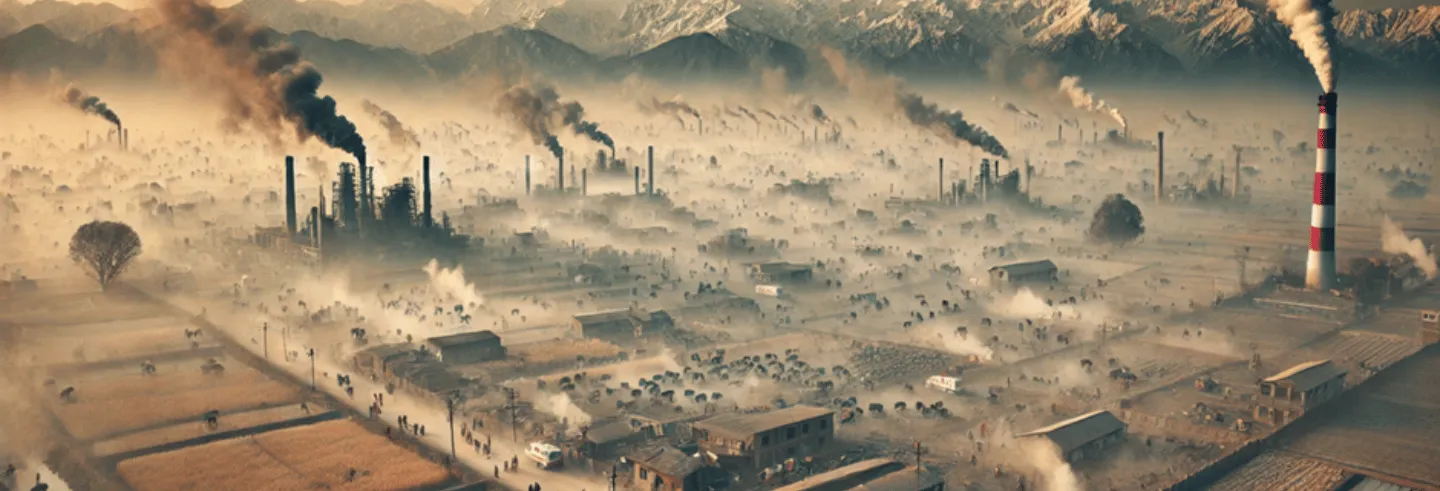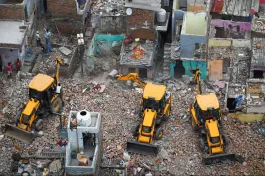By Saroj Kanta Mishra, Pankaj Upadhyaya, Anirudh Arora, Advaith J. Vinod, Navaneetha Jayan, and Ashish Dwivedi
The Indo-Gangetic plain has once again entered its annual season of choking smog. The brief reprieve offered by the monsoon has ended; the skies are turning hazy, and the air is beginning to feel heavy. Just a few weeks ago, in early September, the region had experienced a rare, beautiful calm—washed by late monsoon rains, the air was fresh and clean, sunlight soft, each breath light and invigorating. That fleeting moment now feels like a distant memory as the smog returns, and air quality is expected to further worsen in the coming weeks—a stark reminder of how relentless this crisis has become.
Although Diwali fireworks and stubble burning are often seen as the main culprits, this year’s deterioration was evident even before these events. In 2024, Delhi’s PM₂.₅ levels remained alarmingly high—surpassing 2023’s peak—even as stubble burning declined (Roy Chowdhury and Kaur 2025). In November 2024, some areas recorded Air Quality Index (AQI) levels of 1,700—a figure once unimaginable and rarely observed elsewhere—underscoring the severity of the crisis and the urgent need for long-term, effective interventions. For over a decade, the Indo-Gangetic plain has remained trapped in this persistent crisis, with recent studies emphasising the necessity of sustained action (Editorial 2024: 1018; Dipoppa and Gulzar 2024: 1125; Balsari and Mohanan 2024: 1055; Guttikunda 2024: 569).
The coincidence of Diwali and stubble burning with the peak pollution season often reinforces the perception that these are the main culprits. In reality, they produce sharp, event-driven spikes in a pollution-prone atmosphere that is already heavily polluted—a crisis fundamentally driven by structural and geographic factors. The Indo-Gangetic plain’s bowl-shaped terrain, stable atmospheric layers, and weak winds trap pollutants naturally, while industrial activity, dense urbanisation, and continuous emissions sustain this background pollution. While curbing event-driven spikes is critical, as they can be deadly, addressing persistent background pollution is essential to breaking this cycle. These structural and geographic drivers underpin the chronic crisis, as explored in detail later in this article.
The future looks even bleaker if left unchecked, as rapid industrialisation will further intensify the challenges posed by the region’s pollution-prone geography. Geopolitical shifts, such as the diversification of global supply chains, and climate change are likely to exacerbate the crisis. Transboundary winds add another layer of complexity, making multinational cooperation essential even as regional dynamics continue to evolve.
The problem is far more complex than it is often perceived and goes far beyond Diwali fireworks and stubble burning. Measures aimed at reducing pollution during peak periods, as well as individual precautions, provide only temporary relief—they do not address the root causes. It is high time to look beyond superficial explanations and tackle the deeper, systemic factors driving this crisis. Sustainable clean air in the Indo-Gangetic plain is achievable, but only through long-term, transformative actions that address structural and systemic drivers, and not by relying on short-term, reactive measures.
Pollution-prone Geography
The Indo-Gangetic plain’s pollution-prone geography exacerbates the air quality crisis. Enclosed by tall mountain ranges, the low-lying plain experiences restricted wind flow and limited ventilation. Its flat terrain and weak winds, coupled with winter temperature inversions that trap cooler air near the surface, further hinder pollutant dispersal. This is compounded by the region’s subtropical location beneath the descending branches of the Hadley and Walker cells, two major atmospheric circulation systems. The Hadley cell is like a giant conveyor belt that moves air between the equator and the subtropics in both the hemispheres. The Walker cell is an east-west circulation, with its ascending branch over the western equatorial Pacific and descending branches on its eastern and western flanks. The overlapping descending branches of these cells over the Indo-Gangetic plain lead to persistent atmospheric subsidence, where cold, heavy air sinks to create a stratified atmosphere during the winter months. These combined geographical factors contribute to prolonged periods of poor air quality.
The Indo-Gangetic plain’s pollution-prone geography exacerbates the air quality crisis.
While geographically altering such a vast region is impractical, the Indo-Gangetic plain’s unique landscape necessitates long-term industrial planning that minimises pollution. Crucially, the region’s fertile land and abundant water resources make it a vital agricultural hub—a significant advantage compared with the geographically constrained areas south and west of the Indo-Gangetic plain in India and Pakistan. This underscores the need for region-specific industrial policies that balance economic development with environmental sustainability.
Triple Crisis
The rapid pace of industrialisation across the Indo-Gangetic plain is fuelling the air pollution crisis. Driven by large-scale projects, including industrial corridors and special economic zones, this rapid development, while aimed at economic progress, is intensifying pollution in multiple ways.
Beyond the direct increase in industrial emissions, this growth fuels migration, leading to increased human activity, energy demand, traffic, fuel consumption, and urbanisation—all of which further degrade air quality. While these industrial and infrastructure developments may yield short-term economic gains, the long-term health consequences could be devastating and could turn the region into a ‘sick’ zone. Industrial development is essential, but it cannot come at the cost of public health and future well-being. As the saying goes: only if there is life, is there a world.
Climate change has intensified the Indo-Gangetic plain’s vulnerability to air pollution. Weakening winds (Upadhyaya 2024: 283) and increased atmospheric stability (Fosu 2017: 168) have already exacerbated the region’s pollution woes. Our unpublished data also suggest a strengthening of the subsiding motion of the Walker winds. These trends are projected to continue (Horton et al. 2014: 698; Paulot et al. 2022; Zhou et al. 2024: 7448), further compounding the Indo-Gangetic plain’s pollution burden in coming years. As climate change alters these atmospheric conditions, existing mitigation strategies—designed for present-day climate patterns—will become increasingly ineffective unless adapted to future realities.
While climate change will have global impacts, its effects on air pollution vulnerability will vary regionally. For example, while the Indo-Gangetic plain faces worsening conditions, other regions may experience different trends. Therefore, the projected climate changes in the Indo-Gangetic plain demand climate-adaptive strategies in industrial and infrastructure planning. Such foresight is crucial to safeguard the region’s air quality and the health of its public.
The Indo-Gangetic plain’s air pollution crisis is further complicated by transboundary winds. During winter, predominantly zonal winds carry pollutants from west to east across Pakistan, India, Nepal, and Bangladesh, meaning emissions from one country directly impact its neighbours. Even if one nation implements stringent pollution controls, it remains vulnerable to the pollution generated upstream.
Despite this shared vulnerability, regional cooperation on air quality management remains woefully inadequate. Instead, there is a tendency to overlook pollution that crosses into neighbouring countries, while more bureaucratic action is taken when it flows inward (Editorial 2024: 1018; Dipoppa and Gulzar 2024: 1125; Balsari and Mohanan 2024: 1055). This 'clean homes, dirty neighbourhood' approach highlights the urgent need for collaborative, region-wide solutions.
Bandage Solutions
Every winter, as pollution intensifies, public panic rises, think tanks propose solutions, and governments introduce various initiatives. Common measures include curbing stubble burning, reducing vehicular emissions, improving public transport, and enforcing stricter regulations. Consequently, authorities implement reactive measures such as the odd-even vehicle rule, online school mandates, and temporary construction bans.
These measures are largely driven by the temporal coincidence of pollution spikes with events like stubble burning and Diwali fireworks, fostering the misleading perception that these are the primary culprits. However, Delhi’s PM2.5 levels in 2024 were significantly higher than in 2023, despite a substantial reduction in the often blamed farm fires in Punjab and Haryana. This clearly revealed that the main culprit was elsewhere.
The Indo-Gangetic plain’s current approach—focused on reactive, short-term fixes—has failed to address the underlying causes of pollution.
In reality, these highly visible factors only worsen the problem. The true culprit is the persistent background pollution, which stems from industrialisation and manifests through emissions from industries, vehicles, construction, fuel consumption, waste burning, and other human activities. This is accentuated by the Indo-Gangetic plain’s geographical vulnerability, meaning that the same level of emissions elsewhere would have a lesser impact. Yet, the region’s suitability for such intensive industrialisation is rarely questioned.
Meanwhile, a great deal of research is underway on the Indo-Gangetic plain’s air pollution crisis—ranging from satellite detection of farm fires to AI-based smog forecasting. Yet most of this work is devoted to quantifying and observing the smog, rather than probing the deeper, structural causes that lie beneath the haze. By spotlighting episodic sources like stubble burning or Diwali fireworks, the broader systemic drivers—unchecked industrialisation, structural economic choices, and a geography that traps emissions—remain in the shadows. Unless research and policy begin to look below the surface, the crisis will keep worsening despite ever more precise monitoring and measurement.
Many countries, including US, UK, Germany, Mexico, and China, have successfully improved air quality through long-term, systemic measures. In contrast, the Indo-Gangetic plain’s current approach—focused on reactive, short-term fixes—has failed to address the underlying causes of pollution. These temporary solutions, while necessary to provide some immediate relief, cannot sustainably resolve the crisis. A fundamental shift in focus from reactive measures to proactive, long-term solutions is urgently needed.
Towards a Sustainable Solution
The Indo-Gangetic plain’s air quality crisis is a major threat to public health and carries significant national and regional implications. Unchecked, the health risks could render vast areas uninhabitable, akin to the long-term dangers of nuclear contamination. Lessons from the European Union and China demonstrate that sustained, science-driven policy interventions—including industrial zoning, stringent emissions standards, and investment in green infrastructure—are essential for meaningful air quality improvements. Without such measures, the Indo-Gangetic plain will remain trapped in a cycle of temporary fixes.
As highlighted earlier, this is a complex, deeply rooted problem. A sustainable solution requires addressing the root causes, not merely applying superficial fixes. Governments must act decisively, and the public must recognise and support these measures as crucial for their well-being and that of future generations. Prioritising long-term health and environmental sustainability over short-term gains is paramount.
Tackling this crisis demands a co-ordinated strategy—immediate actions, as we are already in the midst of it, along with systemic reforms and structural transformation to eliminate it permanently.
Industrialisation in the Indo-Gangetic plain is not just an environmental challenge—it also requires careful political and policy management. The drive for rapid economic growth can sometimes make it difficult to implement long-term, sustainable measures. Inter-state competition and shifting political dynamics may further complicate efforts, highlighting the need to balance immediate economic gains with lasting solutions.
This deeply rooted and multi-faceted challenge requires more than superficial solutions. While daunting, history shows that crises can drive transformative change. Tackling this crisis demands a co-ordinated strategy—immediate actions, as we are already in the midst of it, along with systemic reforms and structural transformation to eliminate it permanently.
Transboundary winds necessitate a collective regional response. A legally binding treaty among the Indo-Gangetic plain nations, building on the South Asian Association for Regional Cooperation (SAARC) Convention on Cooperation on Environment (1997), but focused specifically on air quality, is crucial. This treaty should include robust enforcement mechanisms, drawing inspiration from regional frameworks like the Association of Southeast Asian Nations (ASEAN) Agreement on Transboundary Haze Pollution (2002), while learning from its limitations.
Strategic industrial relocation does not means uprooting people forcefully but rather creating economic incentives and infrastructure in less vulnerable regions.
Concurrently, each country in the region must implement stricter environmental regulations, provide incentives for cleaner technologies, and strategically direct new industrial investments to less vulnerable regions. A detailed investigation and assessment of each country’s geography and climate is essential to determine regional suitability and vulnerability for specific activities. Crucially, because systemic and structural reforms are intended for the long term, this assessment must also incorporate actionable long-term climate projections.
While the credibility of climate projections is a significant hurdle for South Asia, this challenge can be overcome (Mishra et al. 2023: 883). The assessment should then categorise zones based on their suitability for agriculture, low-emission industries, and varying levels of industrial emissions. This readily available data will serve as a crucial guiding tool for systemic reforms and structural transformation.
Holistic Transformation
Sustainable development in the Indo-Gangetic plain requires integrating systemic reforms with structural transformations. Development planning must align with climatic and geographical suitability, prioritising agriculture in fertile regions and situating industries in areas with better natural ventilation to mitigate pollution build-up. A holistic, long-term strategy is essential to balance economic growth with environmental realities.
Large-scale circulation patterns influence a region’s susceptibility to pollution. While some areas are suitable for heavy industries, others are better suited for agriculture or low-emission sectors such as information technology, healthcare, education, research, and creative industries. Key government offices and administrative hubs should be located in regions where high-emission industries are unsuitable, ensuring balanced and sustainable regional development. Achieving this transformation requires strong interstate cooperation and long-term sustainability commitments. Climate information must be integrated into long-term policy and governance to ensure a holistic and sustainable transformation.
Climate information must be integrated into long-term policy and governance to ensure a holistic and sustainable transformation.
Planning must incorporate credible climate projections because shifting climatic trends may change a region’s suitability for industries. Industrial investments should be directed toward climatically viable regions, reducing pollution pressure on vulnerable areas like the Indo-Gangetic plain and promoting balanced growth. Lessons from China and Europe highlight the benefits of regional zoning, where high-emission industries are strategically placed in areas better suited for them, minimising environmental and health risks.
To implement these strategies effectively, all new projects—public and private—should require mandatory geographic and climate suitability clearance. A central agency, staffed with geographers and climate scientists, should evaluate project feasibility based on air quality, wind patterns, and future climate trends. Violations should incur significant penalties, and strict timelines must be enforced to prevent bureaucratic delays.
Concluding Remarks
While the proposed reforms may seem daunting, history and global examples prove their feasibility. Countries like China, UK, and Japan have successfully tackled severe air pollution through strict regulations, industrial reforms, and urban planning. China’s regional zoning strategies have successfully relocated polluting industries away from vulnerable basins such as the Sichuan and the north China plains, supported by investments in cleaner sectors and stricter emissions controls (Wei et al. 2025: 107682). These cases show that, though complex, zoning can be achieved incrementally through long-term planning, strong governance, and sustained political will.
Home to more than 500 million people, the Indo-Gangetic plain is not only an agricultural hub but also a region with considerable socio-economic challenges. Relocating industries and directing future industrialisation to climatically suitable regions present significant governance challenges. However, history shows that economic migration within a country is a well-established phenomenon, driven by the pursuit of better opportunities, security, and improved living conditions.
With careful planning, incentives, and strong political commitment, even deeply challenging reforms involving relocation or structural transformation can be effectively implemented.
The suggested solution does not call for halting industrial growth or displacing communities. Strategic industrial relocation does not mean uprooting people forcefully but rather creating economic incentives and infrastructure in less vulnerable regions, naturally guiding future workforce migration. It is therefore a call for a fundamental, long-term industrial transformation ensuring a more equitable and sustainable path than rapid, unplanned urbanisation.
While proposals such as strategic industrial relocation and regional zoning may seem daunting and socially sensitive, history demonstrates that systemic reforms affecting large populations can be successfully implemented despite initial resistance. For instance, China’s regional zoning strategies have relocated polluting industries away from vulnerable regions, contributing to measurable reductions in air pollution in these regions (Ge et al. 2022: 910668).
Similarly, India’s Green Revolution in the 1960s and 1970s transformed agricultural practices nationwide, requiring farmers and local administrations to adopt high-yield crops, modern irrigation methods, and new input systems. Despite initial hesitation, sustained government support, extension services, and policy enforcement ensured the programme’s success, ultimately achieving national food self-sufficiency.
In addition, historical initiatives such as the chak-bandi land consolidation programmes required farmers to leave land to which they were deeply attached and relocate to new plots. Though initially met with reluctance, these reforms became routine over time, improving agricultural efficiency and regional planning. Collectively, these examples illustrate that with careful planning, incentives, and strong political commitment, even deeply challenging reforms involving relocation or structural transformation can be effectively implemented. This provides a strong precedent for the Indo-Gangetic plain’s proposed industrial zoning and sustainable development strategies.
Moreover, societies have mobilised under extreme circumstances—such as during conflicts—demonstrating the power of collective action when faced with urgent challenges. If such mobilisation is possible in times of crisis, it can certainly be achieved for a sustainable and healthier future.
Such a monumental transformation, however, requires a human-centric approach that offers a prosperous path for everyone. For a population that opts for relocation, the policy’s success hinges on creating new industrial hubs or 'growth poles' that are designed as integrated, attractive smart cities. These hubs would offer not just jobs but also superior infrastructure, high-quality housing, and social amenities, enabling a voluntary, opportunity-driven migration.
For the communities that remain in the Indo-Gangetic plain, the solution is to redefine agriculture itself. Instead of remaining a low-income sector, agriculture can be transformed into a high-value, organised industry by promoting value-added agriculture and agro-processing—shifting the region from an unsustainable industrial corridor to a sustainable food corridor. This approach would empower communities to create regional quality brands for indigenous products such as basmati rice, lentils, or spices.
Addressing this challenge requires moving beyond fragmented measures toward a coordinated, science-driven approach supported by strong and sustained commitment.
A powerful model for this is India’s Amul dairy co-operative movement, which empowered millions of small-scale farmers by providing them with the infrastructure to process and brand their products. This approach fosters a thriving, diversified rural economy that creates non-agricultural jobs and boosts incomes, ensuring that no one is left behind and that sustainable development goes hand in hand with economic prosperity.
The crisis is persistent and critical. While short-term economic priorities are important, they must be balanced with the imperative of safeguarding public health. Addressing this challenge requires moving beyond fragmented measures toward a coordinated, science-driven approach supported by strong and sustained commitment.
Alongside policy reforms, scientists and the media play a vital role in raising public awareness about this life-threatening crisis, which is already affecting health and life expectancy. This ongoing effort is crucial—not only to support systemic improvements but also to empower people to make informed decisions for their well-being. Public awareness can guide protective measures and individual choices, helping communities reduce exposure and minimise health risks.
Saroj Kanta Mishra is a professor at Indian Institute of Technology, Delhi and leads the DST Centre of Excellence for Climate Information. Pankaj Upadhyaya and Ashish Dwivedi are research scholars at IIT Delhi. Anirudh Arora, Advaith J. Vinod, and Navaneetha Jayan, students at IISER Bhopal, were visiting scholars at IIT Delhi during the research for this work.









